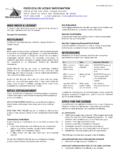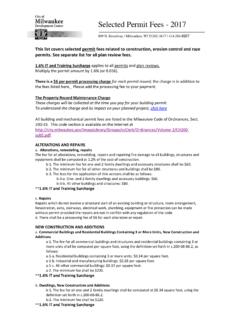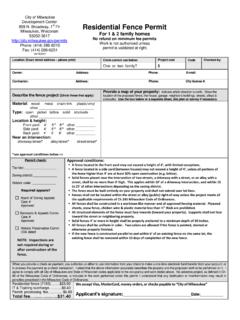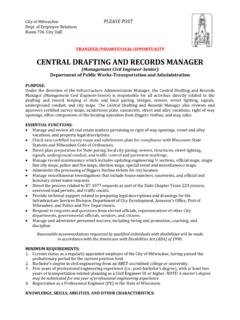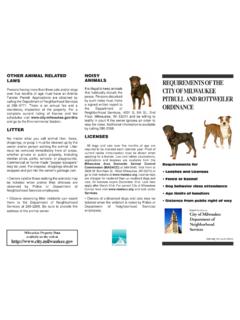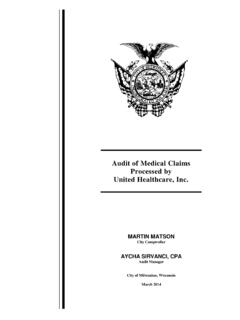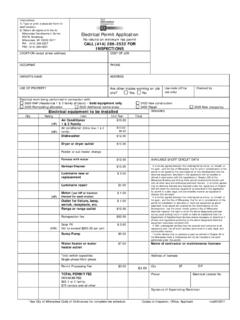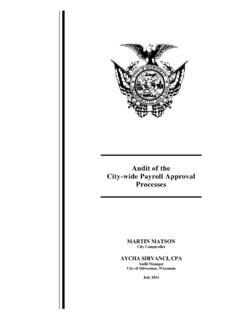Transcription of Color Breathing Exercise - Milwaukee
1 Color Breathing Exercise for Stress Relief Color Breathing is a simple stress reducing activity that may be quickly learned. In short, involves mentally picturing/meditating on a Color that represents how you want to feel or and what you want to let go in your life (stressor). One starts by getting in a comfortable position and allowing oneself to relax. Breathe comfortably and deeply but keep the rhythm of your Breathing natural and relaxed. Remember, your exhale should be twice as long as your inhale (2seconds:4 seconds). Now imagine yourself bathed in the Color of your choice. As you breathe, imagine the Color entering your solar plexus (above the abdomen) and spreading throughout your whole body. As you breathe out visualize the complementary Color leaving your body. Color Meanings Blue Blue is the Color of relaxation and peace.
2 You should imagine blue when you need to relax and unwind. Blue is good if you are suffering from insomnia. It can also be visualized when you need to clear the mind or when you are having problems thinking clearly. The complementary Color of blue is orange. Green Green is Color of healing. Use green to cleanse, balance and purify your body. It is a good Color if you need to relax as it helps to balance and improve your thoughts. The complementary Color of green is red. Magenta Magenta is the Color of release. Use magenta when you need to let go of negative thoughts or ideas. It helps facilitate any type of change and brings out your spiritual energies. The complementary Color of magenta is lime green. Orange Orange is the Color of fun, happiness and joy. Use orange if you are feeling lifeless and depressed. The complementary Color of orange is blue.
3 Red Red is the Color of energy and vitality. It increases your strength and sexuality. Use red when you lack energy or are exhausted. The complementary Color of red is green. Turquoise Turquoise is used to calm and soothe. It strengthens the immune system and can help feverish conditions and inflammations. Use turquoise if you feel dominated by other people or always give in to their thoughts or ideas. The complementary Color of turquoise is yellow. Violet Violet is the Color of self dignity and respect. Use violet if you lack self esteem. It is also useful when you find you are putting yourself down or start to feel that you can t achieve your goals. The complementary Color of violet is yellow-brown. Yellow Yellow is the Color for studying and concentrating. It stimulates intellect and increases your ability to be objective. It increases detachment and helps if you are feeling oversensitive or controlled by other people or when you find it difficult to let go of something.
4 The complementary Color of yellow is turquoise Learning to use Color Breathing can help improve your life, whatever your problem may be. Practice the technique whenever necessary and you will begin to see the benefits almost immediately. Progressive muscle relaxation involves a two-step process in which you systematically tense and relax different muscle groups in the body. With regular practice, progressive muscle relaxation gives you an intimate familiarity with what tension as well as complete relaxation feels like in different parts of the body. This awareness helps you spot and counteract the first signs of the muscular tension that accompanies stress. And as your body relaxes, so will your mind. You can combine deep Breathing with progressive muscle relaxation for an additional level of stress relief. Progressive Muscle Relaxation for Stress Relief Consult with your doctor if you have a history of muscle spasms, back problems, or other serious injuries that may be aggravated by tensing muscles.
5 Most progressive muscle relaxation practitioners start at the feet and work their way up to the face. An example of a typical sequence for muscle groups is found below. 1. Right foot* 2. Left foot 3. Right calf 4. Left calf 5. Right thigh 6. Left thigh 7. Hips and buttocks 8. Stomach 9. Chest 10. Back 11. Right arm and hand 12. Left arm and hand 13. Neck and shoulders 14. Face * If you are left-handed you may want to begin with your left foot instead. Loosen your clothing, take off your shoes, and get comfortable. Take a few minutes to relax, Breathing in and out in slow, deep breaths. When you re relaxed and ready to start, shift your attention to your right foot. Take a moment to focus on the way it feels. Slowly tense the muscles in your right foot, squeezing as tightly as you can. Hold for a count of 10.
6 Relax your right foot. Focus on the tension flowing away and the way your foot feels as it becomes limp and loose. Stay in this relaxed state for a moment, Breathing deeply and slowly. When you re ready, shift your attention to your left foot. Follow the same sequence of muscle tension and release. Move slowly up through your body, contracting and relaxing the muscle groups as you go. It may take some practice at first, but try not to tense muscles other than those intended. Body Scan Meditation for Stress Relief A body scan is similar to progressive muscle relaxation except, instead of tensing and relaxing muscles, you simply focus on the sensations in each part of your body. Practicing body scan meditation Get comfortable and uncross your legs and place arms at your side. You may keep eyes open or closed.
7 Begin by Focusing on your Breathing , allowing your stomach to rise as you inhale and fall as you exhale. Breathe deeply for about two minutes, until you start to feel comfortable and relaxed. Turn your focus to the toes of your right foot. Notice any sensations you feel while continuing to also focus on your Breathing . Imagine each deep breath flowing to your toes. Remain focused on this area for one to two minutes. Move your focus to the sole of your right foot. Tune in to any sensations you feel in that part of your body and imagine each breath flowing from the sole of your foot. After one or two minutes, move your focus to your right ankle and repeat. Move to your calf, knee, thigh, hip, and then repeat the sequence for your left leg. From there, move up the torso, through the lower back and abdomen, the upper back and chest, and the shoulders.
8 Pay close attention to any area of the body that causes you pain or discomfort. Move your focus to the fingers on your right hand and then move up to the wrist, forearm, elbow, upper arm, and shoulder. Repeat for your left arm. Then move through the neck and throat, and finally all the regions of your face, the back of the head, and the top of the head. Pay close attention to your jaw, chin, lips, tongue, nose, cheeks, eyes, forehead, temples and scalp. When you reach the very top of your head, let your breath reach out beyond your body and imagine yourself hovering above yourself. After completing the body scan, relax for a while in silence and stillness, noting how your body feels. Then open your eyes slowly. Take a moment to stretch, if necessary. Mindfulness for Stress Relief Mindfulness is the ability to remain aware of how you re feeling right now, your moment-to-moment experience both internal and external.
9 Thinking about the past blaming and judging yourself or worrying about the future can often lead to a degree of stress that is overwhelming. But by staying calm and focused in the present moment, you can bring your nervous system back into balance. Mindfulness can be applied to activities such as walking, exercising, eating, or meditation. Meditations that cultivate mindfulness have long been used to reduce overwhelming stress. Some of these meditations bring you into the present by focusing your attention on a single repetitive action, such as your Breathing , a few repeated words, or flickering light from a candle. Other forms of mindfulness meditation encourage you to follow and then release internal thoughts or sensations. Practicing mindfulness meditation Key points in mindfulness mediation are: A quiet environment. Choose a secluded place in your home, office, garden, place of worship, or in the great outdoors where you can relax without distractions or interruptions.
10 A comfortable position. Get comfortable, but avoid lying down as this may lead to you falling asleep. Sit up with your spine straight, either in a chair or on the floor. You can also try a cross-legged or lotus position. A point of focus. This point can be internal a feeling or imaginary scene or something external - a flame or meaningful word or phrase that you repeat it throughout your session. You may meditate with eyes open or closed. Also choose to focus on an object in your surroundings to enhance your concentration, or alternately, you can close your eyes. An observant, noncritical attitude. Don t worry about distracting thoughts that go through your mind or about how well you re doing. If thoughts intrude during your relaxation session, don t fight them. Instead, gently turn your attention back to your point of focus.
